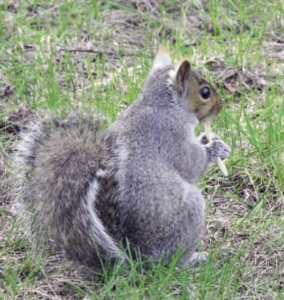SCORES & OUTDOORS: What are all the cries and tail wagging about?

 by Roland D. Hallee
by Roland D. Hallee
A couple of weeks ago, I wrote about different colored squirrels and what was the cause. That prompted an email from a reader who wrote, “Might you consider writing about their various calls? A week ago Thursday, I heard something making noise in my far tree line. After listening for about a half hour, I started to walk out and look, and it stopped. Sounded like a pained cry followed by what sounded like repeated pants. Happened over and over. I kept watching for someone on my neighborhood watch page to report a missing pet. On Saturday, I heard the same noise and could see a gray squirrel up in my maple tree making the same sound and flicking its tail in agitation. Mystery solved and feeling relieved that what I first heard wasn’t something dying. Still don’t know what agitated it either time.”
Well, let’s take a look at their tendencies.
A high-pitched squeal can indicate fear or pain, while a low-pitched growl can indicate aggression.
Most likely, the crying is coming from a female who is, let us say, lonely for a little male companionship. But whether it’s a come-hither cry, conversational chattering or a high-pitched chirp to get off their turf, there is nothing we need do for them except let them be.
Red squirrels are known to produce both loud and soft “chucking” noises, a vehement “wrruhh-ing” as well as various moans and teeth chattering. Piercing screams have been documented during particularly aggressive encounters and red kittens produce “shrill piping calls”.
Not moving or moving very slowly if you approach it is a sign a squirrel is sick or injured. Obvious injuries, for example, if it’s been hit by a car or caught by a cat or dog. Swollen or sore areas on the face, which can be a sign of infection. Hunched-over posture.
On the flip side, what sounds do squirrels make when they’re happy?
Squirrels may make barking sounds when they feel threatened or when they want to communicate with other squirrels. Squirrels may make whistling sounds when they are happy or content.
When distressed, squirrel kits make high-pitched, chirping noises similar to birds. Squirrels use sound to protect themselves and their territories. Their alarm calls are made up of screeches, rattles, barks, and snorts.
Squirrels express frustration by twitching their tails when they are angry. Those familiar with these expressive rodents know how they let their anger be known: a guttural growl, a chattering of teeth, a stamping of feet. But the key to interpreting their emotions may also lie somewhere else: in the curve of their majestic, bushy tails.
Ever notice a squirrel staring at you? Mainly fear, but he’s also sizing you up. Squirrels have a lot of predators, which means that to survive, they constantly have to stay alert to potential dangers. When a squirrel encounters a new potential threat, it may stand perfectly still to determine the danger level.
When they are mad, researchers believe tail flagging may be an expression of frustration. Aggression is another big sign of frustration, which explains why many of the squirrels given locked boxes actually attacked the box by biting and dragging it.
Screaming? Squirrels use high-pitched screams or screeches to alert other squirrels of danger. Deep, guttural barks are a squirrel’s way of protecting their territory but may also be part of a mating ritual.
What does it mean when a squirrel barks at you?
The sound can resemble a dog barking but is much more high-pitched. This can be heard when they feel threatened by another animal coming near their territory, or if someone comes too close to them while they are eating. It usually means they are warning other animals to stay away from the area.
Also, shaking their tails is basically a squirrel’s way of shaking a fist at you. They usually do this when they sense a threat somewhere.
What does it mean when a squirrel stands up?
Squirrels also present themselves with a puffed-up, enhanced and erect posture when defending territory. They will often stand on their hind legs to let intruders know they are a formidable enemy should advances be made further into the territory.
So now, when we see those clever, sometimes mischievous critters in the backyard, or those bird feeders they seem to enjoy so much, you might be able to tell what is going through their little heads.
Roland’s trivia question of the week:
What New England Patriots coach took the team to the Super Bowl in his first year of coaching?
Responsible journalism is hard work!
It is also expensive!
If you enjoy reading The Town Line and the good news we bring you each week, would you consider a donation to help us continue the work we’re doing?
The Town Line is a 501(c)(3) nonprofit private foundation, and all donations are tax deductible under the Internal Revenue Service code.
To help, please visit our online donation page or mail a check payable to The Town Line, PO Box 89, South China, ME 04358. Your contribution is appreciated!


Leave a Reply
Want to join the discussion?Feel free to contribute!